Fracturing and Near-Surface Diagenesis of a Silicified Miocene Deltaic Sequence: The Montjuïc Hill (Barcelona)
Abstract
1. Introduction
2. Geological Setting
Host Rock Petrology and Diagenesis
3. Methodology
4. Results
4.1. Fracturing
4.2. Fracture Fillings
4.3. Geochemistry
4.3.1. Elemental and Isotopic Composition of Barite
4.3.2. Elemental and Isotopic Composition of Calcite Cements
4.3.3. Isotopic Composition of Silica Cements
5. Discussion
5.1. Origin of Calcite Cements
5.2. Origin of Barite Formation in Fractures
5.3. Origin and Age of Silicification in Fractures
5.4. Karst Evidence: Silica Dissolution
6. Conclusions
Author Contributions
Funding
Acknowledgments
Conflicts of Interest
References
- Karim, A.; Pe-Piper, G.; Piper, D.J.W. Controls on diagenesis of Lower Cretaceous reservoir sandstones in the western Sable Subbasin, offshore Nova Scotia. Sediment. Geol. 2010, 224, 65–83. [Google Scholar] [CrossRef]
- Morad, S.; Ketzer, J.M.; DeRos, F. Spatial and temporal distribution of diagenetic alterations in siliciclastic rocks: implication for mass transfer in sedimentary basins. Sedimentology 2000, 47, 95–120. [Google Scholar] [CrossRef]
- Ketzer, J.M.; Holz, M.; Morad, S.; Al-Aasm, I.S. Sequence stratigraphic distribution of diagenetic alterations in coal-bearing, paralic sandstones: Evidence from the Rio Bonito Formation (early Permian), southern Brazil. Sedimentology 2003, 50, 855–877. [Google Scholar] [CrossRef]
- El-ghali, M.A.K.; Mansurbeg, H.; Morad, S.; Al-Aasm, I.; Ajdanlisky, G. Distribution of diagenetic alterations in fluvial and paralic deposits within sequence stratigraphic framework: Evidence from the Petrohan Terrigenous Group and the Svidol Formation, Lower Triassic, NW Bulgaria. Sediment. Geol. 2006, 190, 299–321. [Google Scholar] [CrossRef]
- Worden, R.H.; Burley, S.D. Sandstone Diagenesis: The Evolution of Sand to Stone; Blackwell Publishing Ltd.: Hoboken, NJ, USA, 2009; ISBN 9781444304459. [Google Scholar]
- Salem, A.M.; Ketzer, J.M.; Morad, S.; Rizk, R.R.; Al-Aasm, I.S. Diagenesis and Reservoir-Quality Evolution of Incised-Valley Sandstones: Evidence from the Abu Madi Gas Reservoirs (Upper Miocene), the Nile Delta Basin, Egypt. J. Sediment. Res. 2005, 75, 572–584. [Google Scholar] [CrossRef]
- Mansurbeg, H.; Morad, S.; Salem, A.; Marfil, R.; El-ghali, M.A.K.; Nystuen, J.P.; Caja, M.A.; Amorosi, A.; Garcia, D.; La Iglesia, A. Diagenesis and reservoir quality evolution of palaeocene deep-water, marine sandstones, the Shetland-Faroes Basin, British continental shelf. Mar. Pet. Geol. 2008, 25, 514–543. [Google Scholar] [CrossRef]
- Luo, J.L.; Morad, S.; Salem, A.; Ketzer, J.M.; Lei, X.L.; Guo, D.Y.; Hlal, O. Impact of diagenesis on reservoir-quality evolution in fluvial and lacustrine-deltaic sandstones: Evidence from jurassic and triassic sandstones from the Ordos Basin, China. J. Pet. Geol. 2009, 32, 79–102. [Google Scholar] [CrossRef]
- Morad, S.; Al-Ramadan, K.; Ketzer, J.M.; De Ros, L.F. The impact of diagenesis on the heterogeneity of sandstone reservoirs: A review of the role of depositional fades and sequence stratigraphy. Am. Assoc. Pet. Geol. Bull. 2010, 94, 1267–1309. [Google Scholar] [CrossRef]
- Khalifa, M.; Morad, S. Impact of structural setting on diagenesis of fluvial and tidal sandstones: The Bahi Formation, Upper Cretaceous, NW Sirt Basin, North Central Libya. Mar. Pet. Geol. 2012, 38, 211–231. [Google Scholar] [CrossRef]
- Sun, N.; Zhong, J.; Hao, B.; Ge, Y.; Swennen, R. Sedimentological and diagenetic control on the reservoir quality of deep-lacustrine sedimentary gravity flow sand reservoirs of the Upper Triassic Yanchang Formation in Southern Ordos Basin, China. Mar. Pet. Geol. 2020, 112, 104050. [Google Scholar] [CrossRef]
- Chan, M.A.; Parry, W.T.; Bowman, J.R. Diagenetic Hematite and Manganese Oxides and Fault-Related Fluid Flow in Jurass ic Sandstones, Southeastern Utah. AAPG Bull. 2000, 84, 1281–1310. [Google Scholar]
- Ceriani, A.; Di Giulio, A.; Goldstein, R.H.; Rossi, C. Diagenesis associated with cooling during burial: An examplefrom Lower Cretaceous reservoir sandstones (Sirt basin, Libya). Am. Assoc. Pet. Geol. Bull. 2002, 86, 1573–1591. [Google Scholar]
- Andre, G.; Hibsch, C.; Fourcade, S.; Cathelineau, M.; Buschaert, S. Chronology of fracture sealing under a meteoric fluid environment: Microtectonic and isotopic evidence of major Cainozoic events in the eastern Paris Basin (France). Tectonophysics 2010, 490, 214–228. [Google Scholar] [CrossRef]
- Cantarero, I.; Zafra, C.J.; Travé, A.; Martín-martín, J.D.; Baqués, V.; Playà, E. Fracturing and cementation of shallow buried Miocene proximal alluvial fan deposits. Mar. Pet. Geol. 2014, 55, 87–99. [Google Scholar] [CrossRef]
- Cruset, D.; Cantarero, I.; Travé, A.; Vergés, J.; John, C.M. Crestal graben fluid evolution during growth of the Puig-reig anticline (South Pyrenean fold and thrust belt). J. Geodyn. 2016, 101, 30–50. [Google Scholar] [CrossRef]
- Cruset, D.; Cantarero, I.; Vergés, J.; John, C.M.; Muñoz-López, D.; Travé, A. Changes in fluid regime in syn-orogenic sediments during the growth of the south Pyrenean fold and thrust belt. Glob. Planet. Chang. 2018, 171, 207–224. [Google Scholar] [CrossRef]
- Yuan, G.; Cao, Y.; Gluyas, J.; Cao, X.; Zhang, W. Petrography, fluid-inclusion, isotope, and trace-element constraints on the origin of quartz cementation and feldspar dissolution and the associated fluid evolution in arkosic sandstones. Am. Assoc. Pet. Geol. Bull. 2018, 102, 761–792. [Google Scholar] [CrossRef]
- Ulmer-Scholle, D.S.; Scholle, P.A.; Schieber, J.; Raine, R.J. Memoir 109: A Color Guide to the Petrography of Sandstones, Siltstones, Shales and Associated Rocks; Sweet, M.L., Ed.; The American Association of Petroleum Geologists: Tulsa, OK, USA, 2014; ISBN 978-0-89181-389-7. [Google Scholar]
- Daza Brunet, R.; Bustillo Revuelta, M.Á. Exceptional silica speleothems in a volcanic cave: A unique example of silicification and sub-aquatic opaline stromatolite formation (Terceira, Azores). Sedimentology 2014, 61, 2113–2135. [Google Scholar] [CrossRef]
- Khalifa, M.A.; Mansurbeg, H.; Morad, D.; Morad, S.; Al-Aasm, I.S.; Spirov, P.; Ceriani, A.; De Ros, L.F. Quartz and Fe-dolomite cements record shifts in formation-water chemistry and hydrocarbon migration in Devonian shoreface sandstones, Ghadamis Basin, Libya. J. Sediment. Res. 2018, 88, 38–57. [Google Scholar] [CrossRef]
- Menezes, C.P.; Bezerra, F.H.R.; Balsamo, F.; Mozafari, M.; Vieira, M.M.; Srivastava, N.K.; de Castro, D.L. Hydrothermal silicification along faults affecting carbonate-sandstone units and its impact on reservoir quality, Potiguar Basin, Brazil. Mar. Pet. Geol. 2019, 110, 198–217. [Google Scholar] [CrossRef]
- Hervig, R.L.; Williams, L.B.; Kirkland, I.K.; Longstaffe, F.J. Oxygen isotope microanalyses of diagenetic quartz: possible low temperature occlusion of pores. Geochim. Cosmochim. Acta 1995, 59, 2537–2543. [Google Scholar] [CrossRef]
- Ullyott, J.S.; Nash, D.J. Micromorphology and geochemistry of groundwater silcretes in the eastern South Downs, UK. Sedimentology 2006, 53, 387–412. [Google Scholar] [CrossRef]
- Thiry, M.; Milnes, A.; Brahim, M. Ben Pleistocene cold climate groundwater silicification, Jbel Ghassoul region, Missour Basin, Morocco. J. Geol. Soc. London. 2015, 172, 125–137. [Google Scholar] [CrossRef]
- Thiry, M.; Milnes, A. Silcretes: Insights into the occurrences and formation of materials sourced for stone tool making. J. Archaeol. Sci. Reports 2017, 15, 500–513. [Google Scholar] [CrossRef]
- Tritlla, J.; Esteban, M.; Loma, R.; Mattos, A.; Sanders, C.; Vieira De Luca, P.H.; Carrasco, A.; Gerona, M.; Herra, A.; Carballo, J. Where have most of the carbonates gone? Silicified Aptian pre-salt microbial (?) carbonates in South Atlantic basins (Brazil and Angola). In Proceedings of the Bathurst Meeting Mallorca 2019 16th International Meeting of Carbonate Sedimentologists, Palma de Mallorca, Spain, 9–11 July 2019. [Google Scholar]
- Saller, A. Presalt lake evolution in the south Atlantic: the significance of microbial chert. In Proceedings of the Bathurst Meeting Mallorca 2019 16th International Meeting of Carbonate Sedimentologists Presalt, Palma de Mallorca, Spain, 9–11 July 2019. [Google Scholar]
- Travé, A.; Calvet, F. Syn-rift geofluids in fractures related to the early-middle Miocene evolution of the Vallès-Penedès half-graben (NE Spain). Tectonophysics 2001, 336, 101–120. [Google Scholar] [CrossRef]
- Travé, A.; Calvet, F.; Soler, A.; Labaume, P. Fracturing and fluid migration during Palaeogene compression and Neogene extension in the Catalan Coastal Ranges, Spain. Sedimentology 1998, 45, 1063–1082. [Google Scholar] [CrossRef]
- Travé, A.; Roca, E.; Playà, E.; Parcerisa, D.; Gómez-Gras, D.; Martín-Martín, J.D. Migration of Mn-rich fluids through normal faults and fine-grained terrigenous sediments during early development of the Neogene Vallès-Penedès half-graben (NE Spain). Geofluids 2009, 9, 303–320. [Google Scholar] [CrossRef]
- Parcerisa, D.; Gómez-Gras, D.; Travé, A. A model of early calcite cementation in alluvial fans: Evidence from the Burdigalian sandstones and limestones of the Vallès-Penedès half-graben (NE Spain). Sediment. Geol. 2005, 178, 197–217. [Google Scholar] [CrossRef]
- Parcerisa, D.; Gómez-Gras, D.; Martín-Martín, J.D. Calcretes, oncolites, and lacustrine limestones in Upper Oligocene alluvial fans of the Montgat area (Catalan Coastal Ranges, Spain). Geol. Soc. Am. Spec. Pap. 2006, 416, 105–117. [Google Scholar]
- Baqués, V.; Travé, A.; Benedicto, A.; Labaume, P.; Cantarero, I. Relationships between carbonate fault rocks and fluid flow regime during propagation of the Neogene extensional faults of the Penedès basin (Catalan Coastal Ranges, NE Spain). J. Geochem. Explor. 2010, 106, 24–33. [Google Scholar] [CrossRef]
- Baqués, V.; Travé, A.; Roca, E.; Marín, M.; Cantarero, I. Geofluid behaviour in successive extensional and compressional events: a case study from the southwestern end of the Vallès-Penedès Fault (Catalan Coastal Ranges, NE Spain). Pet. Geosci. 2012, 18, 17–31. [Google Scholar] [CrossRef]
- Baqués, V.; Travé, A.; Cantarero, I. Development of successive karstic systems within the Baix Penedès Fault zone (onshore of the Valencia Trough, NW Mediterranean). Geofluids 2014, 14, 75–94. [Google Scholar] [CrossRef]
- Cantarero, I.; Travé, A.; Alías, G.; Baqués, V. Polyphasic hydrothermal and meteoric fluid regimes during the growth of a segmented fault involving crystalline and carbonate rocks (Barcelona Plain, NE Spain). Geofluids 2014, 14, 20–44. [Google Scholar] [CrossRef]
- Miró, J.; Martín-Martín, J.D.; Ibáñez, J.; Anadón, P.; Oms, O.; Tritlla, J.; Caja, M.A. Opaline chert nodules in maar lake sediments from Camp dels Ninots (La Selva Basin, NE Spain). In Proceedings of the Geo-Temas, Huelva, Spain, 12–14 September 2016; Volume 16, pp. 387–390. [Google Scholar]
- Gomez-Gras, D.; Parcerisa, D.; Bitzer, K.; Calvet, F.; Roca, E.; Thiry, M. Hydrogeochemistry and diagenesis of Miocene sandstones at Montjuic, Barcelona (Spain). J. Geochem. Explor. 2000, 69, 177–182. [Google Scholar] [CrossRef]
- Gomez-Gras, D.; Parcerisa, D.; Calvet, F.; Porta, J.; Solé de Porta, N.; Civís, J. Stratigraphy and petrology of the Miocene Montjuïc delta: (Barcelona, Spain). Acta Geològica Hispànica 2001, 36, 115–136. [Google Scholar]
- Parcerisa, D. Petrologia i diagènesi en sediments de l’Oligocè superior i del Miocè inferior i mitjà de la depressió del Vallès i del Pla de Barcelona; Universitat Autònoma de Barcelona: Barcelona, Spain, 2002. [Google Scholar]
- Parcerisa, D.; Thiry, M.; Gomez-Gras, D.; Calvet, F. Tentative model for the silicification in Neogene Montjuic sandstones, Barcelona (Spain): authigenic minerals, geochemical environment and fluid flow. Bull. La Soc. Geol. Fr. 2001, 172, 751–764. [Google Scholar] [CrossRef]
- Roca, E.; Sans, M.; Cabrera, L.; Marzo, M. Oligocene to Middle Miocene evolution of the central Catalan margin (northwestern Mediterranean). Tectonophysics 1999, 315, 209–233. [Google Scholar] [CrossRef]
- Roca, E.; Guimerà, J. The Neogene structure of the eastern Iberian margin—Structural constraints on the crustal evolution of the Valencia trough (Western Mediterranean). Tectonophysics 1992, 203, 203–218. [Google Scholar] [CrossRef]
- Gaspar-Escribano, J.M.; Garcia-Castellanos, D.; Roca, E.; Cloetingh, S. Cenozoic vertical motions of the Catalan Coastal Ranges (NE Spain): The role of tectonics, isostasy, and surface transport. Tectonics 2004, 23, TC1004. [Google Scholar] [CrossRef]
- Calvet, F.; Travé, A.; Roca, E.; Soler, A.; Labaume, P. Fracturación y migración de fluidos durante la evolución tectónica neógena en el Sector Central de las Cadenas Costero Catalanas. Geogaceta 1996, 20, 1715–1718. [Google Scholar]
- Julivert, M.; Duran, H. Paleozoic stratigraphy of the Central and Northern part of the Catalonian Coastal Ranges (NE Spain). Acta Geol. Hisp. 1990, 25, 3–12. [Google Scholar]
- Llopis Lladó, N. Tectomorfología del macizo del Tibidabo y valle inferior del Llobregat. Estud. Geográficos 1942, 3, 321–383. [Google Scholar]
- Roca, J.L.; Casas, A. Gravimetria en zona urbana. Mapa Gravimétrico de la Ciudad de Barcelona; IV Asamblea Nacional de Geodesia y Geofísica. Presidencia de Gobierno. Comisión Nacional de Geodesia y Geofísica; Asamblea Nacional de Geodesia y Geofisica: Barcelona, Spain, 1981. [Google Scholar]
- Blow, W.H. Late Middle Eocene to Recent planktonic foraminiferal biostratigraphy. In Proceedings of the First International Conference on Planktonic Microfossils, Geneva, Switzerland; Bronnimann, P., Renz, H.H., Eds.; Brill Archive: Leiden, The Netherlands, 1969; pp. 199–421. [Google Scholar]
- BouDagher-Fadel, M.K. Biostratigraphic and Geological Significance of Planktonic Foraminifera; UCLPress: London, UK, 2018; ISBN 978-1-910634-24-0. [Google Scholar]
- Riba, O.; Colombo, F. Barcelona: la Ciutat Vella i el Poblenou. Assaig de geologia urbana; Institut d’Estudis Catalans i Reial Acadèmia de Ciències i Arts de Barcelona: Barcelona, Spain, 2009. [Google Scholar]
- Friedman, I.; O’Neil, J.; Cebula, G. Two New Carbonate Stable-Isotope Standards. Geostand. Newsl. 1982, 6, 11–12. [Google Scholar] [CrossRef]
- Hut, G. Consultants’ Group Meeting on Stable Isotope Reference Samples for Geochemical and Hydrological Investigations; International Atomic Energy Agency (IAEA): Vienna, Austria, 1987; p. 42. [Google Scholar]
- Sharp, Z.D. A laser-based microanalytical method for the in situ determination of oxygen isotope ratios of silicates and oxides. Geochim. Cosmochim. Acta 1990, 54, 1353–1357. [Google Scholar] [CrossRef]
- Halas, S.; Szaran, J. Improved thermal decomposition of sulfates to SO2 and mass spectrometric determination of δ34S of IAEA SO-5, IAEA SO-6 and NBS-127 sulfate standards. Rapid Commun. Mass Spectrom. 2001, 15, 1618–1620. [Google Scholar] [CrossRef]
- Claypool, G.E.; Holser, W.T.; Kaplan, I.R.; Sakai, H.; Zak, I. The age curves of sulfur and oxygen isotopes in marine sulfate and their mutual interpretation. Chem. Geol. 1980, 28, 199–260. [Google Scholar] [CrossRef]
- McBride, E.F.; Milliken, K.L.; Cavazza, W.; Cibin, U.; Fontana, D.; Picard, M.D.; Zuffa, G.G. Heterogeneous distribution of calcite cement at the outcrop scale in Tertiary sandstones, northern Apennines, Italy. Am. Assoc. Pet. Geol. Bull. 1995, 79, 1044–1063. [Google Scholar]
- Moore, C.H. Carbonate Diagenesis and Porosity. Developments in Sedimentology 46; Elsevier Science Bv.: Amsterdam, The Netherlands, 1989; ISBN 0444874151. [Google Scholar]
- Tucker, M.E.; Wright, P.V. Carbonate Sedimentology; Blackwell: Oxford, UK, 1990. [Google Scholar]
- Rossi, C.; Canaveras, J.C. Pseudospherulitic fibrous calcite in paleo-groundwater, unconformity-related diagenetic carbonates (Paleocene of the Ager Basin and Miocene of the Madrid Basin, Spain). J. Sediment. Res. 1999, 69, 224–238. [Google Scholar] [CrossRef]
- Parcerisa, D.; Gómez-Gras, D.; Travé, A.; Martín-Martín, J.D. Fe and Mn in calcites cementing red beds: A record of oxidation–reduction conditionsExamples from the Catalan Coastal Ranges (NE Spain). J. Geochem. Explor. 2006, 89, 318–321. [Google Scholar] [CrossRef]
- Abdel-Wahab, A.; McBride, E.F. Anonymous Origin of giant calcite-cemented concretions, Temple Member, Qasr El Sagha Formation (Eocene), Faiyum Depression, Egypt. J. Sediment. Res. 2001, 71, 70–81. [Google Scholar] [CrossRef]
- McBride, E.F.; Parea, G.C. Origin of highly elongate, calcite-cemented concretions in some Italian coastal beach and dune sands. J. Sediment. Res. 2001, 71, 82–87. [Google Scholar] [CrossRef]
- Cerling, T.E. The stable isotopic composition of modern soil carbonate and its relationship to climate. Earth Planet. Sci. Lett. 1984, 71, 229–240. [Google Scholar] [CrossRef]
- Veizer, J.; Ala, D.; Azmy, K.; Bruckschen, P.; Buhl, D.; Bruhn, F.; Carden, G.A.F.; Diener, A.; Ebneth, S.; Godderis, Y.; et al. 87Sr/Sr86, d13 C and d18 O evolution of Phanerozoic seawater. Chem. Geol. 1999, 161, 59–88. [Google Scholar] [CrossRef]
- Craig, H. The measurements of oxygen isotope paleotemperatures. In Stable Isotopes in Oceanographic Studies and Paleotemperatures; Consiglio Nazionale delle, Richerche; Laboratorio di Geologia Nucleare; Tongiorgi, E., Ed.; Pisa: Rome, Italy, 1965; pp. 161–182. [Google Scholar]
- Juez-Larré, J. Post late Paleozoic Tectonothermal Evolution of the Northeastern Margin of Iberia, Assessed by Fission-Track and (U-Th)/He Analyses. A Case History from the Catalan Coastal Ranges. Ph.D. Thesis, Vrije Universiteit, Amsterdam, The Netherlands, 2003. [Google Scholar]
- Alonso, F.; Peón, A.; Villanueva, O.; Rosell, J.; Trilla, J.; Obrador, A. Mapa y Memoria Explicativa de la Hoja no421 (Barcelona) del Mapa Geológico Nacional a Escala 1:50,000; IGME: Madrid, Spain, 1977. [Google Scholar]
- Carmona, J.M.; Bitzer, K.; López, E.; Bouazza, M. Isotopic composition and origin of geothermal waters at Caldetes (Maresme-Barcelona). J. Geochem. Explor. 2000, 69–70, 441–447. [Google Scholar] [CrossRef]
- Cardellach, E.; Canals, À.; Grandia, F. Recurrent hydrothermal activity induced by successive extensional episodes: The case of the Berta F-(Pb-Zn) vein system (NE Spain). Ore Geol. Rev. 2002, 22, 133–141. [Google Scholar] [CrossRef]
- Gallart, J.; Rojas, H.; Diaz, J.; Dañobeitia, J.J. Features of deep crustal structure and the onshore-offshore transition at the Iberian flank of the Valencia Trough (Western Mediterranean). J. Geodyn. 1990, 12, 233–252. [Google Scholar] [CrossRef]
- Vidal, N.; Gallart, J.; Dañobeitia, J.J. Contribution of the ESCI-Valéncia Trough Wide-Angle Data to a Crustal Transect in the NE Iberian Margin. Rev. la Soc. Geol. Espana 1997, 8, 417–429. [Google Scholar]
- Seal, R.R. Sulfur Isotope Geochemistry of Sulfide Minerals. Rev. Mineral. Geochem. 2006, 61, 633–677. [Google Scholar] [CrossRef]
- Fisher, I.S. Pyrite formation in bioturbated clays from the Jurassic of Britain. Geochim. Cosmochim. Acta 1986, 50, 517–523. [Google Scholar] [CrossRef]
- Chowdhury, A.H.; Noble, J.P.A. Organic carbon and pyrite sulphur relationships as evidences of bottom water conditions of sedimentation, Albert Formation fine-grained lacustrine sediments, New Brunswick, Canada. Mar. Pet. Geol. 1996, 13, 79–90. [Google Scholar] [CrossRef]
- Machel, H.G. Bacterial and thermochemical sulfate reduction in diagenetic settings—Old and new insights. Sediment. Geol. 2001, 140, 143–175. [Google Scholar] [CrossRef]
- Habicht, K.S.; Canfield, D.E. Sulphur isotope fractionation in modern microbial mats and the evolution of the sulphur cycle. Nature 1996, 382, 342–343. [Google Scholar] [CrossRef]
- Aharon, P.; Fu, B. Microbial sulfate reduction rates and sulfur and oxygen isotope fractionations at oil and gas seeps in deepwater Gulf of Mexico. Geochim. Cosmochim. Acta 2000, 64, 233–246. [Google Scholar] [CrossRef]
- Hanor, J.S. Barite-Celestine Geochemistry and Environments of Formation. Rev. Mineral. Geochem. 2000, 40, 193–275. [Google Scholar] [CrossRef]
- Palmer, M.R.; Edmond, J.M. Controls over the strontium isotope composition of river water. Geochim. Cosmochim. Acta 1992, 56, 2099–2111. [Google Scholar] [CrossRef]
- Hanor, J.S. A model for the origin of large carbonate- and evaporite-hosted celestine (SrSO4) deposits. J. Sediment. Res. 2004, 74, 168–175. [Google Scholar] [CrossRef]
- Marshall, W.L.; Warakomski, J.M. Amorphous silica solubilities-II. Effect of aqueous salt solutions at 25°C. Geochim. Cosmochim. Acta 1980, 44, 915–924. [Google Scholar] [CrossRef]
- Marshall, W.L.; Chen, C.-T.A. Amorphous silica solubilities V. Predictions of solubility behavior in aqueous mixed electrolyte solutions to 300 °C. Geochim. Cosmochim. Acta 1982, 46, 289–291. [Google Scholar] [CrossRef]
- Thiry, M.; Milnes, A.R.; Rayot, V.; Simon-Coinçon, R. Interpretation of palaeoweathering features and successive silicifications in the Tertiary regolith of inland Australia. J. Geol. Soc. London. 2006, 163, 723–736. [Google Scholar] [CrossRef]
- Thiry, M.; Milnes, A.R. Pedogenic and groundwater silcretes at Stuart Creek opal field, South Australia. J. Sediment. Petrol. 1991, 61, 111–127. [Google Scholar]
- Blanco, J.A.; Armenteros, I.; Huerta, P. Silcrete and alunite genesis in alluvial palaeosols (late Cretaceous to early Palaeocene, Duero basin, Spain). Sediment. Geol. 2008, 211, 1–11. [Google Scholar] [CrossRef]
- Aubrecht, R.; Lánczos, T.; Gregor, M.; Schlögl, J.; Šmída, B.; Liščák, P.; Brewer-Carías, C.; Vlček, L. Sandstone caves on Venezuelan tepuis: Return to pseudokarst? Geomorphology 2011, 132, 351–365. [Google Scholar] [CrossRef]
- Thiry, M.; Millot, G. Mineralogical Forms of Silica and their Sequence of Formation in Silcretes. SEPM J. Sediment. Res. 1987, 57, 343–352. [Google Scholar]
- Milnes, A.R.; Thiry, M. Silcretes. In Weathering, Soils and Palaeosols. Developments in Earth Surface Processes 2; Martini, I.P., Chesworth, W., Eds.; Elsevier: Amsterdam, The Netherlands, 1992; pp. 349–377. [Google Scholar]
- Thiry, M.; Simon-Coinçon, R. Tertiary paleoweatherings and silcretes in the southern Paris Basin. Catena 1996, 26, 1–26. [Google Scholar] [CrossRef]
- Ullyott, J.S.; Nash, D.J.; Huggett, J.M. Cap structures as diagnostic indicators of silcrete origin. Sediment. Geol. 2015, 325, 119–131. [Google Scholar] [CrossRef]
- Bantcev, D.V.; Ganyushkin, D.A.; Chistyakov, K.V.; Volkov, I.V.; Ekaykin, A.A.; Veres, A.N.; Tokarev, I.V.; Shtykova, N.B.; Andreeva, T.A. The Components of the Glacial Runoff of the Tsambagarav Massif from Stable Water Isotope Data. Geosciences 2019, 9, 297. [Google Scholar] [CrossRef]
- Krumbein, W.C.; Garrels, R.M. Origin and Classification of Chemical Sediments in Terms of pH and Oxidation-Reduction Potentials. J. Geol. 1952, 60, 1–33. [Google Scholar] [CrossRef]
- Meyer, R.; Pena dos Reis, R.B. Paleosols and alunite in continental Cenozoic of western Portugal. J. Sediment. Res. 1985, 55, 76–85. [Google Scholar]
- Raymahashay, B.C. A geochemical study of rock alteration by hot springs in the Paint Pot Hill area, Yellowstone Park. Geochim. Cosmochim. Acta 1968, 32, 499–522. [Google Scholar] [CrossRef]
- Wray, R.A.L. Alunite formation within silica stalactites from the Sydney Region, South-Eastern Australia. Int. J. Speleol. 2011, 40, 109–116. [Google Scholar] [CrossRef][Green Version]
- Thiry, M.; Schmitt, J.; Innocent, C.; Cojan, I. Sables et Grès de Fontainebleau: Que reste-t-il des faciès sédimentaires initiaux? In Proceedings of the 14ème Congrès Français de Sédimentologie, Paris, France, 4–8 November 2013; Association des Sédimentologistes Français: Paris, France, 2013; Volume 74, pp. 37–90. [Google Scholar]
- Cantarero, I.; Lanari, P.; Vidal, O.; Alías, G.; Travé, A.; Baqués, V. Long-term fluid circulation in extensional faults in the central Catalan Coastal Ranges: P–T constraints from neoformed chlorite and K-white mica. Int. J. Earth Sci. 2014, 103, 165–188. [Google Scholar] [CrossRef]
- Vesica, P.L.; Tuccimei, P.; Turi, B.; Fornós, J.J.; Ginés, A.; Ginés, J. Late Pleistocene Paleoclimates and sea-level change in the Mediterranean as inferred from stable isotope and U-series studies of overgrowths on speleothems, Mallorca, Spain. Quat. Sci. Rev. 2000, 19, 865–879. [Google Scholar] [CrossRef]
- Jiménez de Cisneros, C.; Caballero, E.; Vera, J.A.; Durán, J.J.; Juliá, R. A record of pleistocene climate from a stalactite, Nerja Cave, southern Spain. Palaeogeogr. Palaeoclimatol. Palaeoecol. 2003, 189, 1–10. [Google Scholar] [CrossRef]
- Wray, R.A.L. Quartzite dissolution: Karst or pseudokarst? Cave Karst Sci. 1997, 24, 81–86. [Google Scholar]
- Sauro, F.; Lundberg, J.; De Waele, J.; Tisato, N.; Galli, E. Speleogenesis and speleothems of the Guacamaya cave, Auyan tepui, Venezuela. In Proceedings of the Karst and Caves in Other Rocks, Pseudokarst, 16th International Congress of Speleology, Brno, Czech Republic, 21–28 July 2013; pp. 298–304. [Google Scholar]
- Martini, J.E.J. Karst in Black Reef Quartzite near Kaapsehoop, Eastern Transvaal. Ann. S. Afr. Geol. Surv. 1979, 13, 115–128. [Google Scholar]
- Martini, J.E.J. Dissolution of quartz and silicate minerals. In Speleogenesis: Evolution of Karst Aquifers; Klimchouk, A.B., Ford, D.C., Palmer, A.N., Dreybrodt, W., Eds.; National Speleological Society: Huntsville, AL, USA, 2000; pp. 452–457. [Google Scholar]
- Wray, R. A global review of solutional weathering forms on quartz sandstones. Earth-Science Rev. 1997, 42, 137–160. [Google Scholar] [CrossRef]
- Piccini, L.; Mecchia, M. Solution weathering rate and origin of karst landforms and caves in the quartzite of Auyan-tepui (Gran Sabana, Venezuela). Geomorphology 2009, 106, 15–25. [Google Scholar] [CrossRef]
- Sauro, F. Structural and lithological guidance on speleogenesis in quartz–sandstone: Evidence of the arenisation process. Geomorphology 2014, 226, 106–123. [Google Scholar] [CrossRef]
- Wray, R.A.L. Phreatic drainage conduits within quartz sandstone: Evidence from the Jurassic Precipice Sandstone, Carnarvon Range, Queensland, Australia. Geomorphology 2009, 110, 203–211. [Google Scholar] [CrossRef]
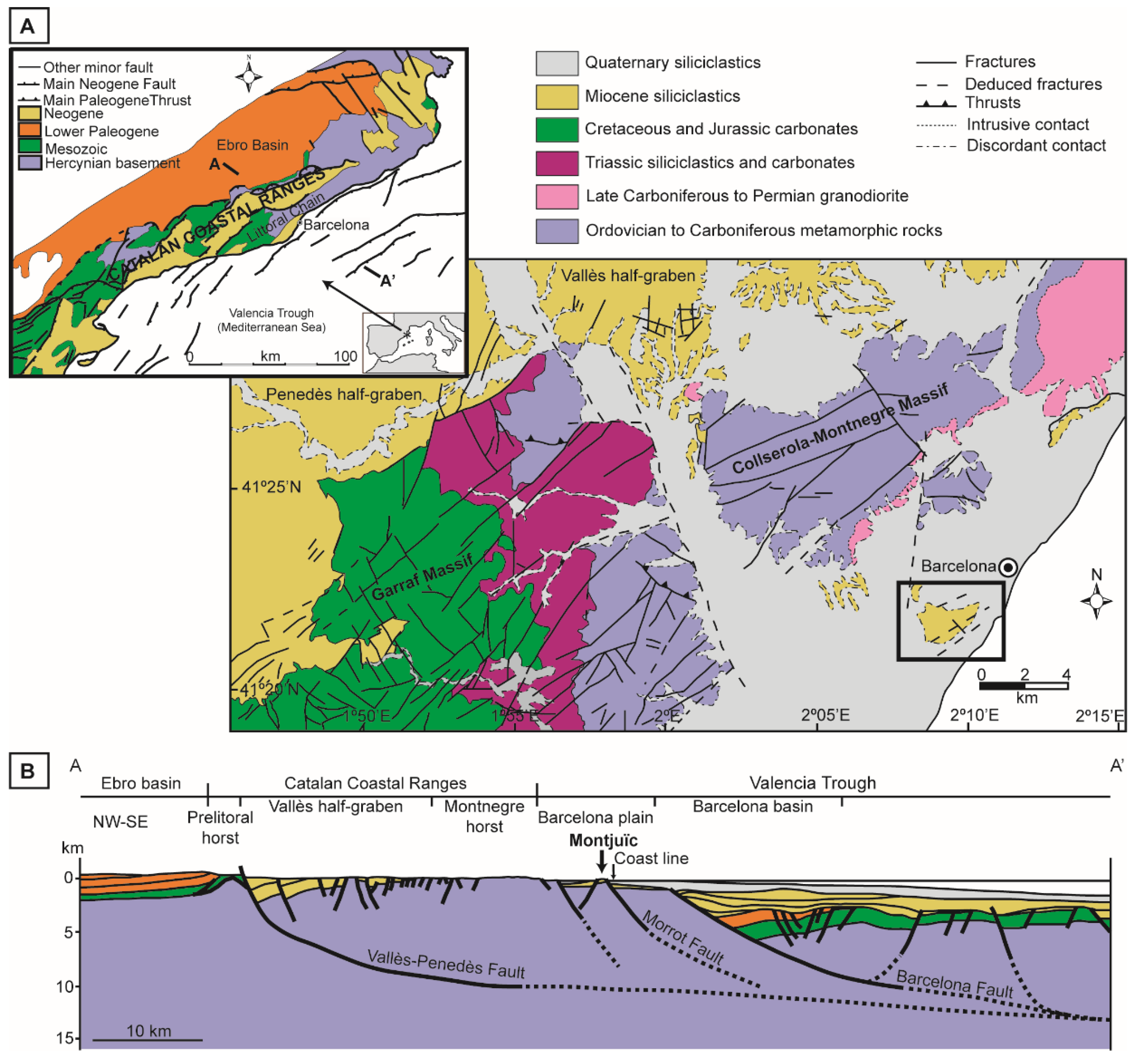
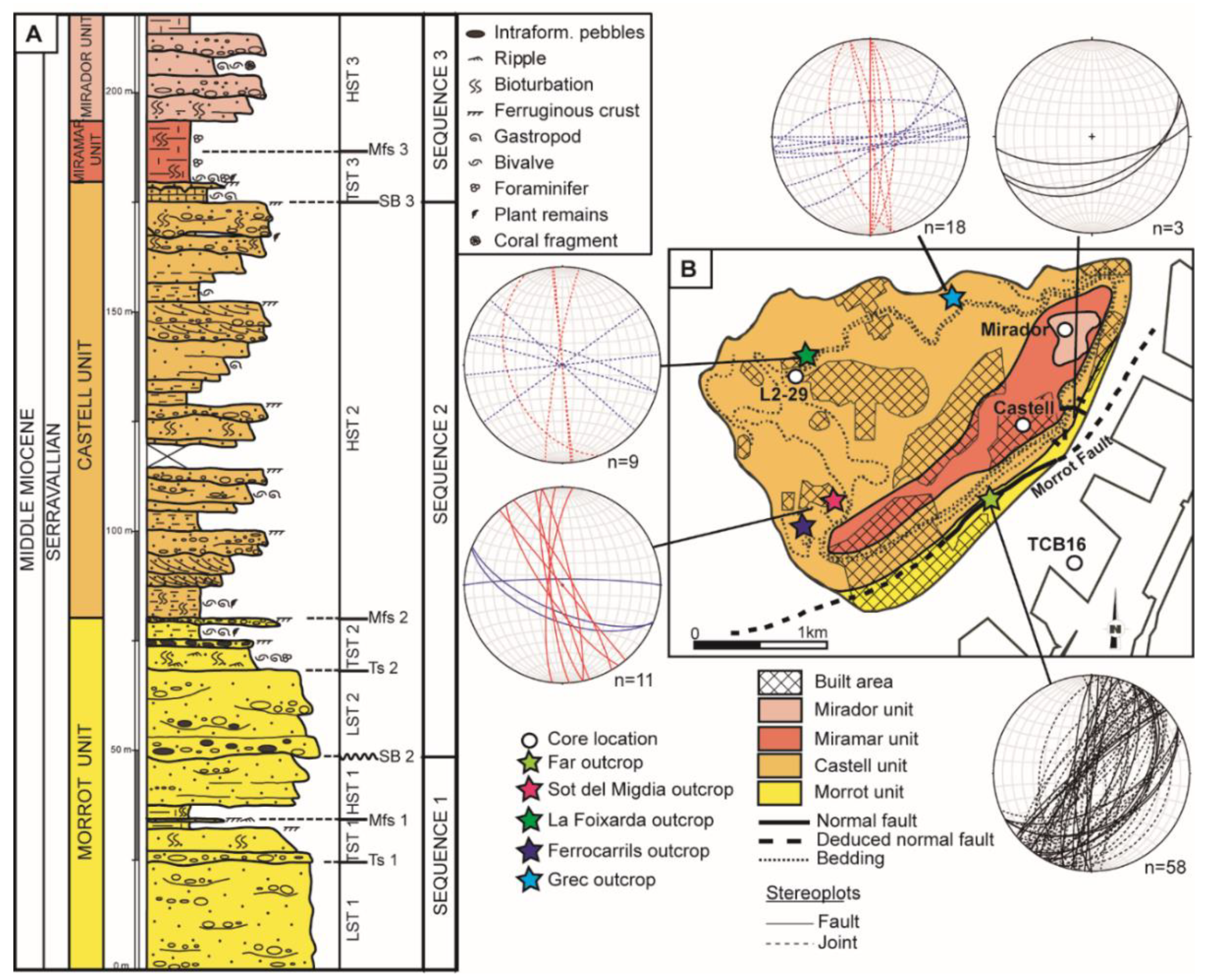

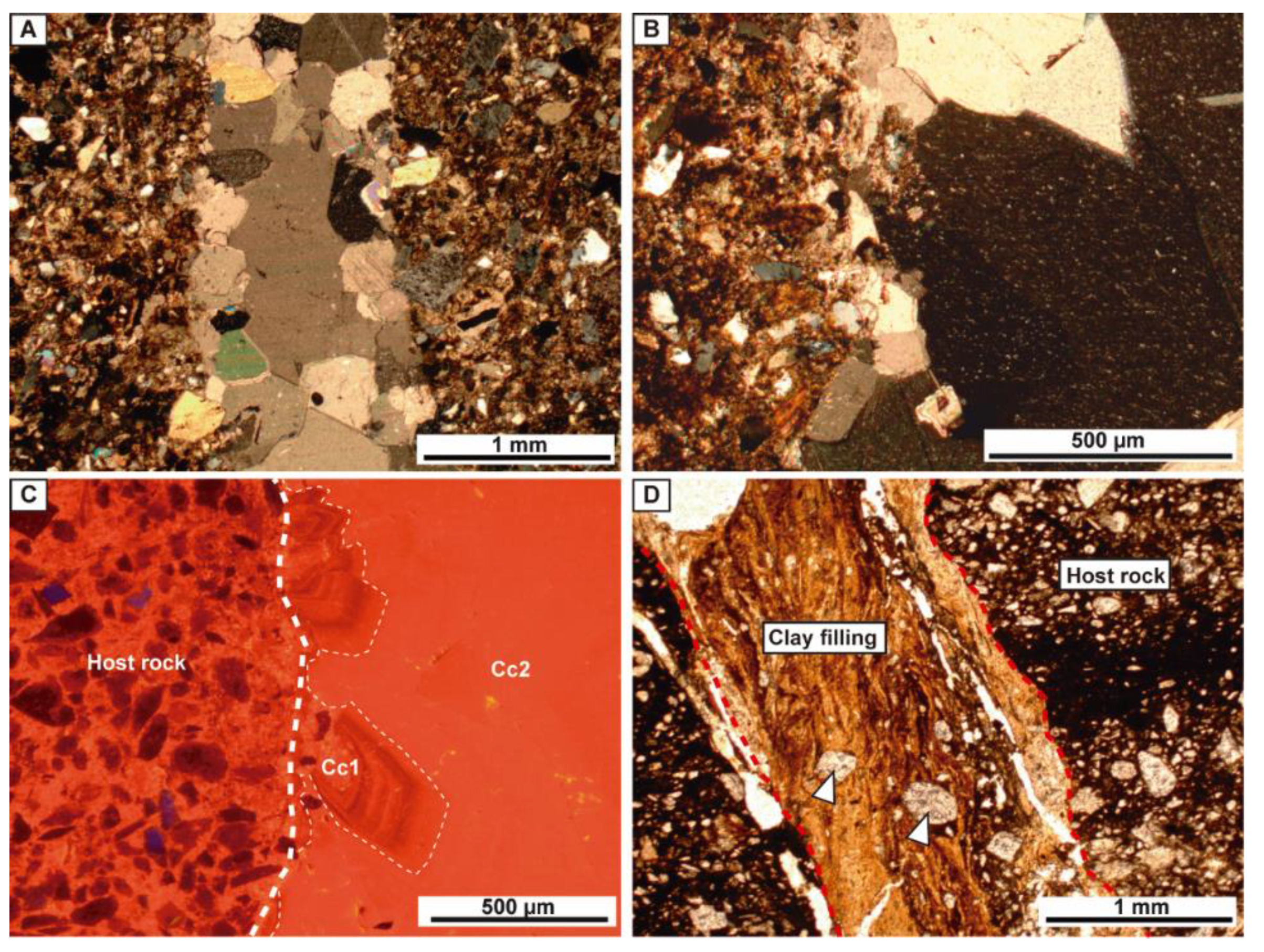
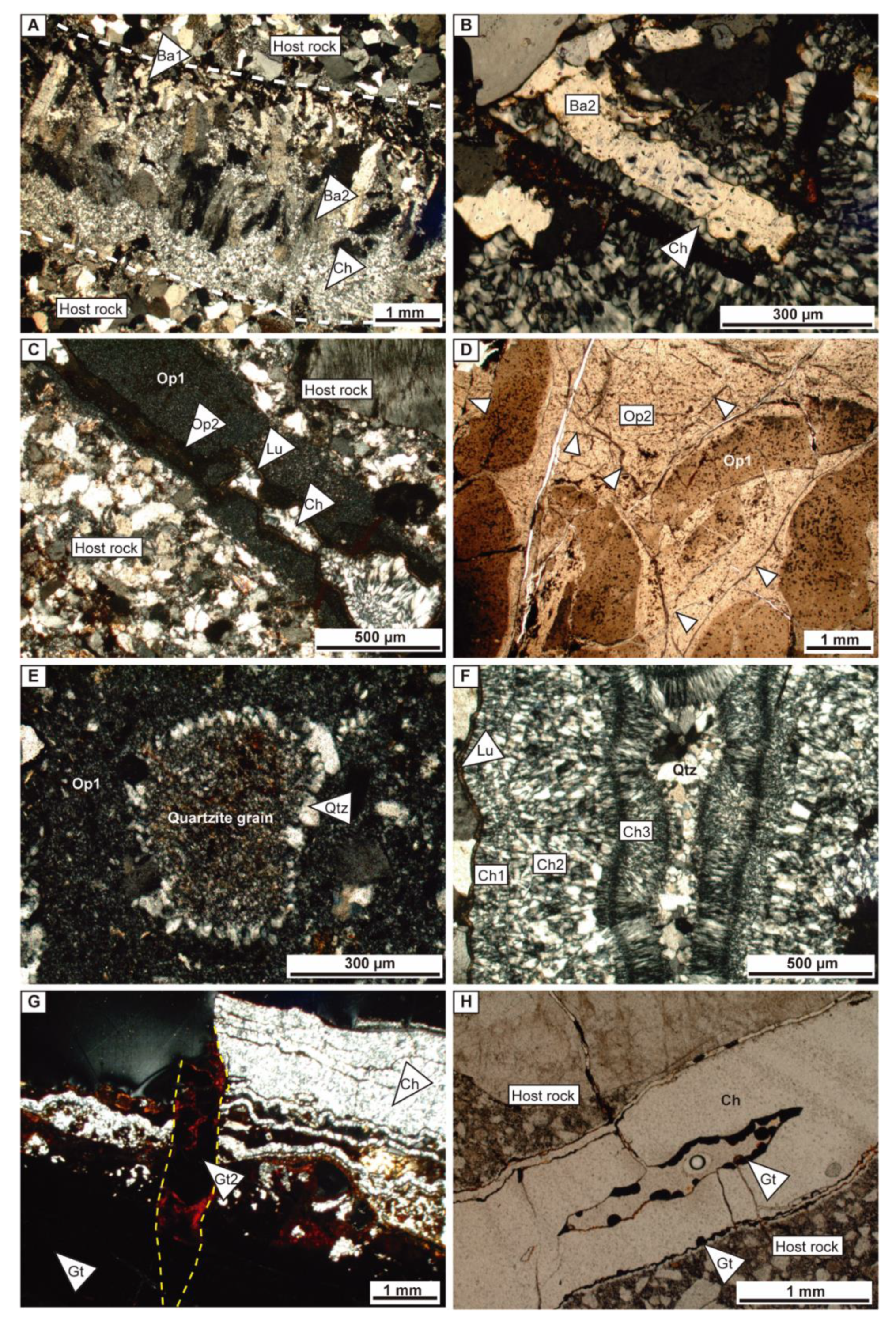
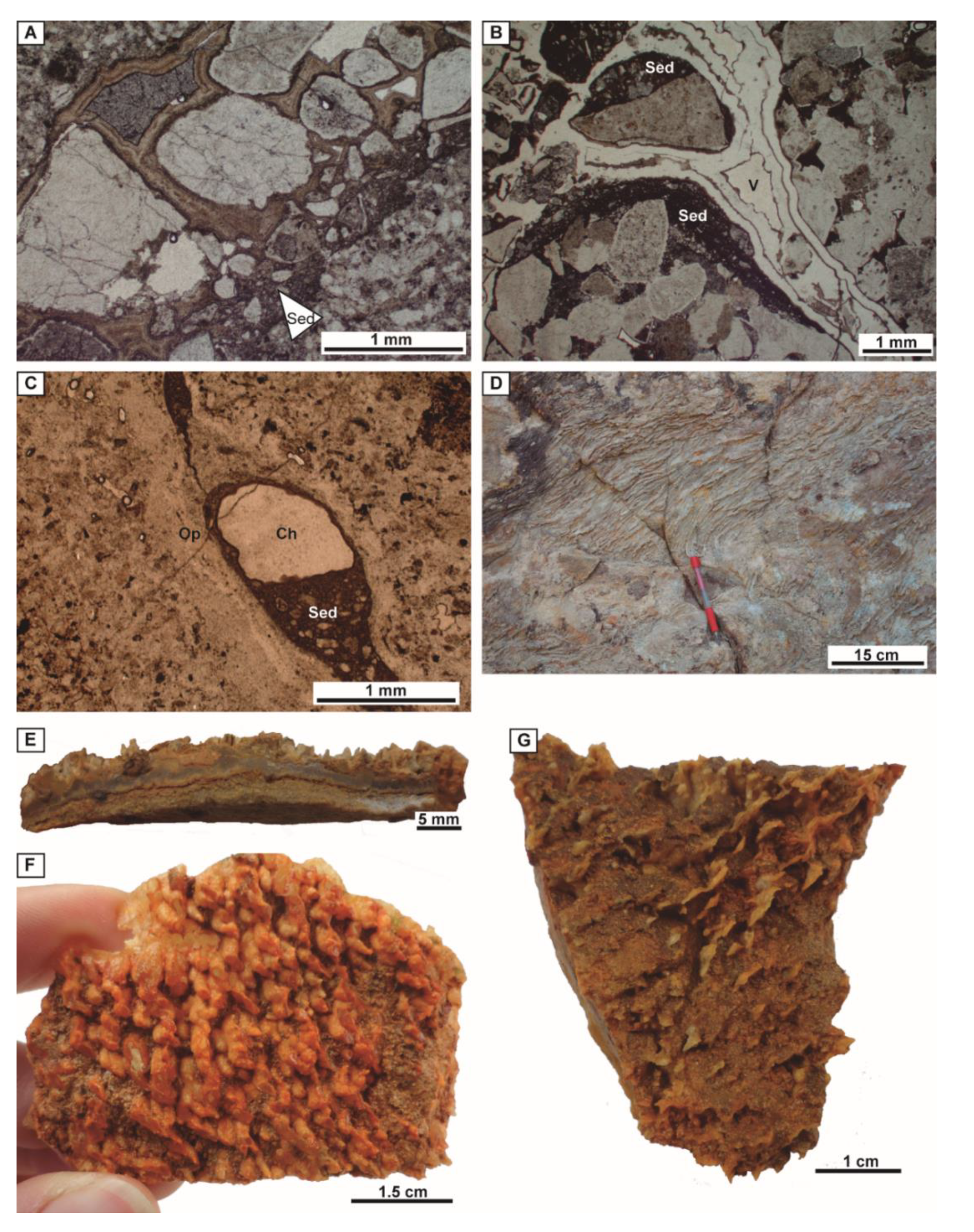
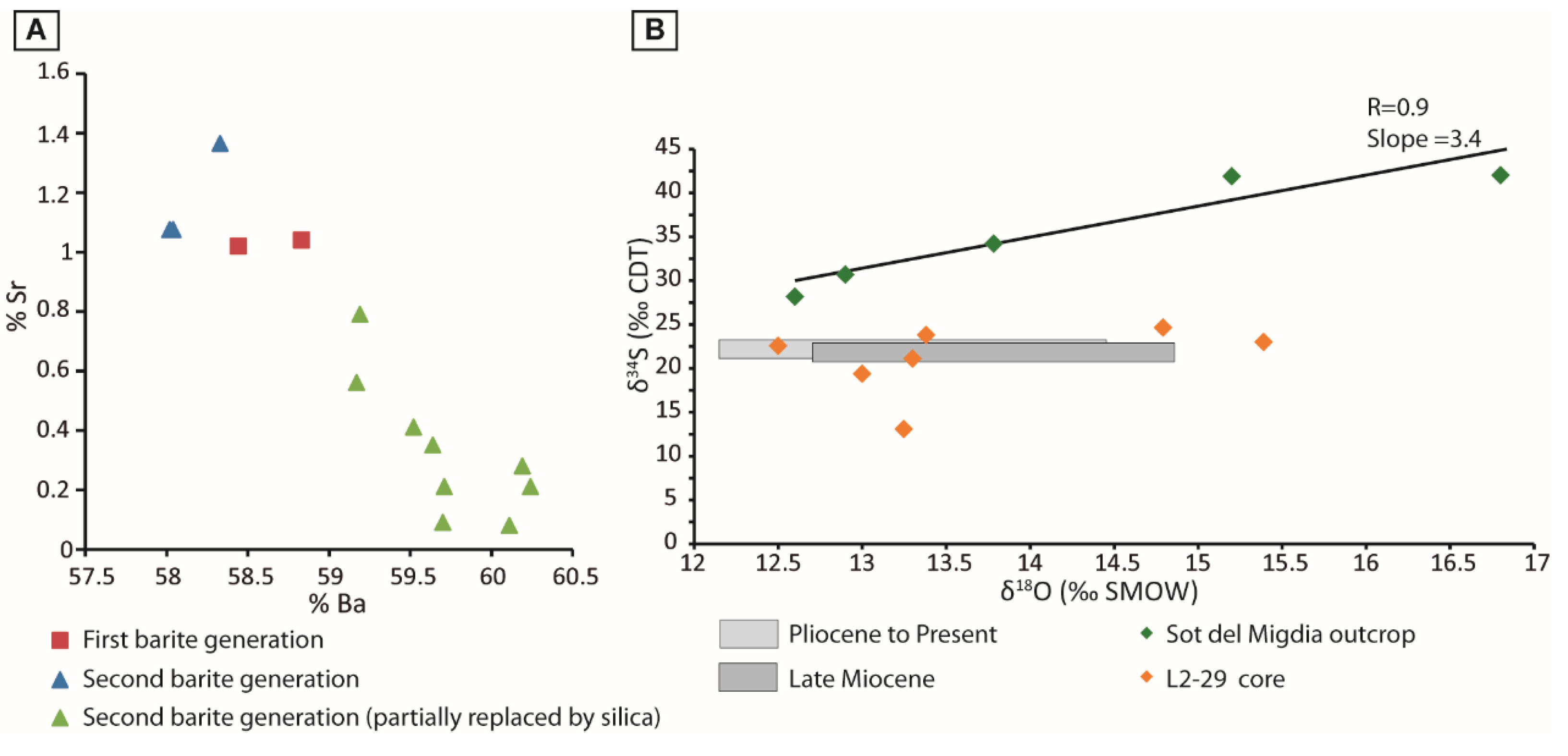
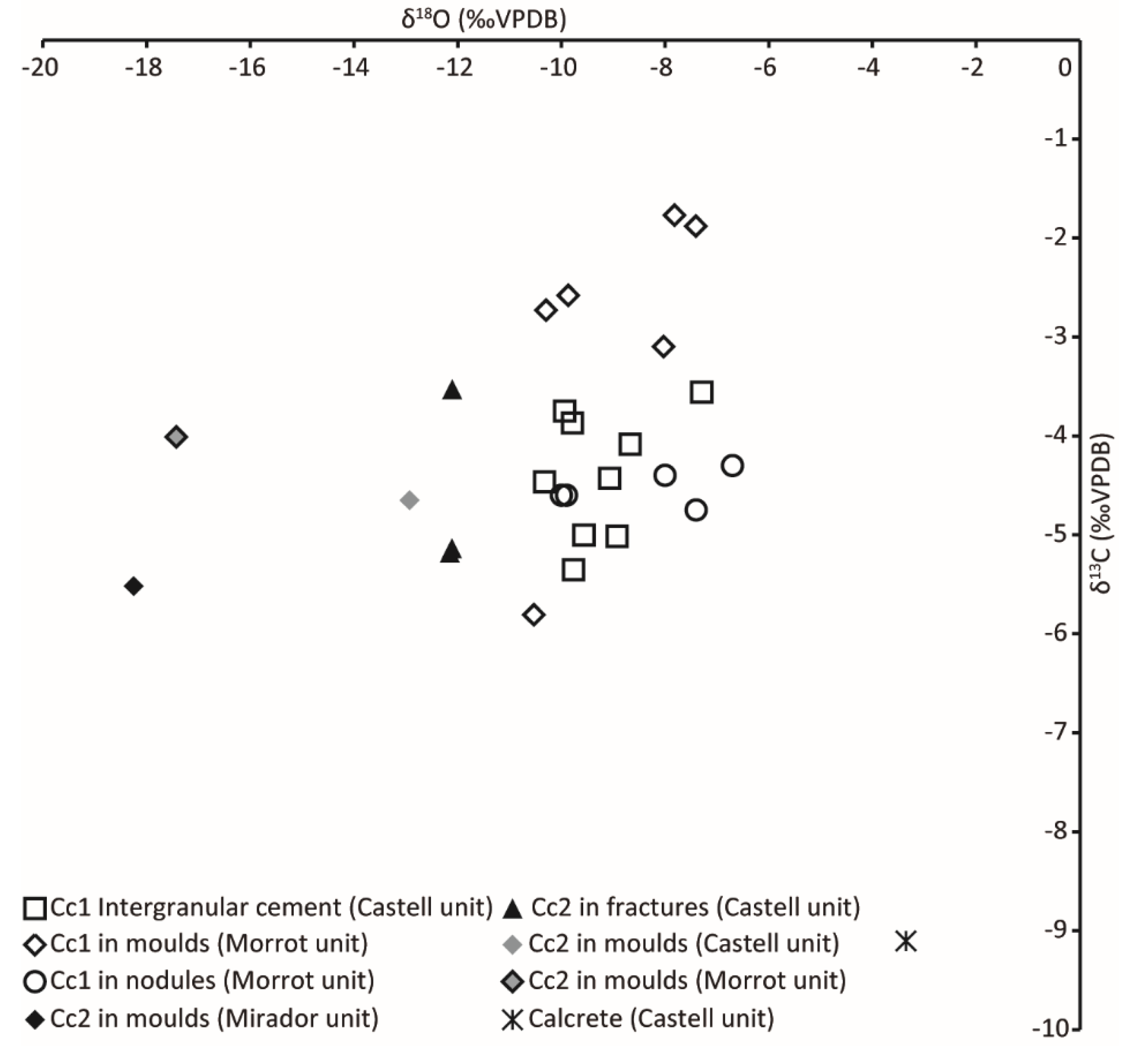
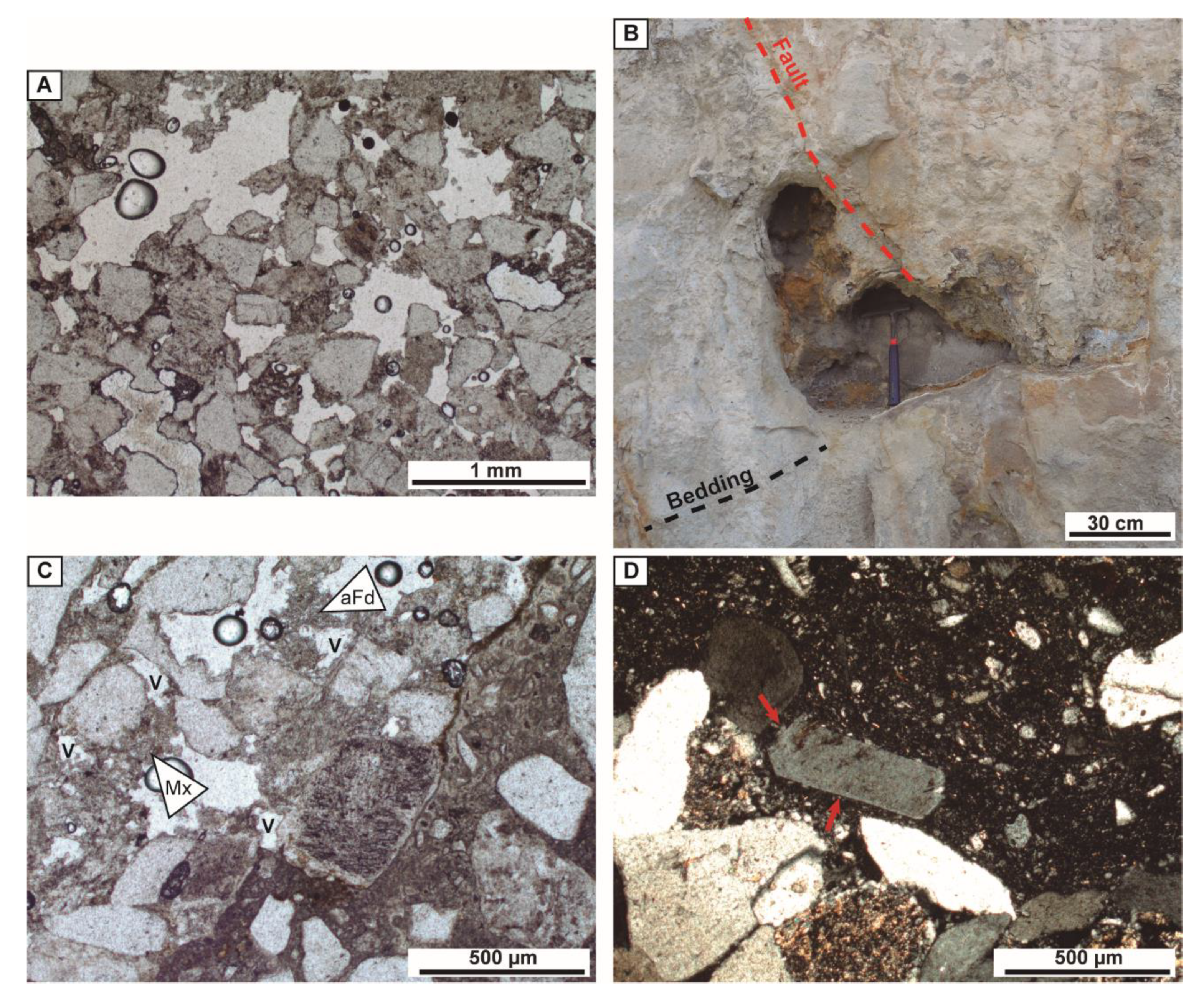
| Sample | δ34S (‰CDT) | δ18O (‰SMOW) | 87Sr/86Sr | Location and Description |
|---|---|---|---|---|
| S29-12 A | 23.8 | 13.4 | L2-29 core at 35.20 m (±jarosite) | |
| S29-12 B | 22.6 | 12.5 | L2-29 core at 35.20 m (+iron oxides) | |
| S29-1 | 19.4 | 13 | 0.712446 | L2-29 core at 37.85 m (+chalcedony) |
| S29-2 | 21.1 | 13.3 | L2-29 core at 37.85 m (+chalcedony) | |
| S29-14 B | 22.7 | 15.4 | L2-29 core at 39 m (+chalcedony) | |
| S29-20 A | 24.7 | 14.8 | L2-29 core at 47 m. Next to fracture wall (+ch) | |
| S29-20 B | 13.1 | 13.2 | L2-29 core at 47 m. Far from fracture wall (+ch) | |
| MTJ-32 A | 42 | 16.8 | 0.712939 | Sot del Migdia. Next to fracture wall |
| MTJ-32 B | 28.2 | 12.6 | Sot del Migdia. Central part of the fracture | |
| MTJ-32 C | 34.2 | 13.8 | 0.715218 | Sot del Migdia. Far from fracture wall |
| FMP-21a | 30.7 | 12.9 | Sot del Migdia | |
| FMP-21b | 41.9 | 15.2 | Sot del Migdia |
| Cement Generation | Statistics | ppm Mg | ppm Ca | ppm Mn | ppm Fe | ppm Sr | ppm Na |
|---|---|---|---|---|---|---|---|
| min | <d.l. | 382,700 | <d.l. | <d.l. | <d.l. | <d.l. | |
| Cc1 Fractures | max | 2584 | 403,564 | 7079 | 2028 | 665 | <d.l. |
| n = 23 | average | 712 | 392,395 | 3452 | 645 | 285 | <d.l. |
| min | <d.l. | 383,978 | 1300 | <d.l. | <d.l. | <d.l. | |
| Cc2 Fractures | max | 2500 | 392,893 | 14,272 | 3100 | 400 | <d.l. |
| n = 12 | average | <d.l. | 388,025 | 8288 | 669 | 228 | <d.l. |
| Cc1 Intergranular | min | <d.l. | 377,236 | 277 | <d.l. | <d.l. | <d.l. |
| cement | max | 1269 | 398,220 | 5885 | 24,189 | 1060 | <d.l. |
| n = 17 | average | 611 | 390,352 | 3124 | 4263 | 351 | <d.l. |
| Sample | δ18O (‰SMOW) | Location and Description |
|---|---|---|
| MTJ-31-1 | 16.4 | Ferrocarrils. Chalcedony botryoids in fracture |
| MTJ-37-1 | 12.4 | La Foixarda. Chalcedony stalactite nucleus |
| MTJ-37-2 | 23.4 | La Foixarda. Chalcedony stalactite cover |
| MTJ-38-1 | 25.2 | La Foixarda. Outer stalactitic layer |
| MTJ-38-2 | 22.3 | La Foixarda. Inner stalactitic layer |
| MTJ-3A | 18.8 | El Far. Chessboard and fibrous chalcedony crosscut by iron oxides |
| S29-14A | 9.2 | L2-29 core. Chalcedony associated with barite in fracture |
| S29-17A | 10.3 | L2-29 core. Radial fibrous chalcedony |
| SR9B-03A | 10 | Castell core. Quartz in a vug |
© 2020 by the authors. Licensee MDPI, Basel, Switzerland. This article is an open access article distributed under the terms and conditions of the Creative Commons Attribution (CC BY) license (http://creativecommons.org/licenses/by/4.0/).
Share and Cite
Cantarero, I.; Parcerisa, D.; Plata, M.A.; Gómez-Gras, D.; Gomez-Rivas, E.; Martín-Martín, J.D.; Travé, A. Fracturing and Near-Surface Diagenesis of a Silicified Miocene Deltaic Sequence: The Montjuïc Hill (Barcelona). Minerals 2020, 10, 135. https://doi.org/10.3390/min10020135
Cantarero I, Parcerisa D, Plata MA, Gómez-Gras D, Gomez-Rivas E, Martín-Martín JD, Travé A. Fracturing and Near-Surface Diagenesis of a Silicified Miocene Deltaic Sequence: The Montjuïc Hill (Barcelona). Minerals. 2020; 10(2):135. https://doi.org/10.3390/min10020135
Chicago/Turabian StyleCantarero, Irene, David Parcerisa, Maria Alexandra Plata, David Gómez-Gras, Enrique Gomez-Rivas, Juan Diego Martín-Martín, and Anna Travé. 2020. "Fracturing and Near-Surface Diagenesis of a Silicified Miocene Deltaic Sequence: The Montjuïc Hill (Barcelona)" Minerals 10, no. 2: 135. https://doi.org/10.3390/min10020135
APA StyleCantarero, I., Parcerisa, D., Plata, M. A., Gómez-Gras, D., Gomez-Rivas, E., Martín-Martín, J. D., & Travé, A. (2020). Fracturing and Near-Surface Diagenesis of a Silicified Miocene Deltaic Sequence: The Montjuïc Hill (Barcelona). Minerals, 10(2), 135. https://doi.org/10.3390/min10020135






